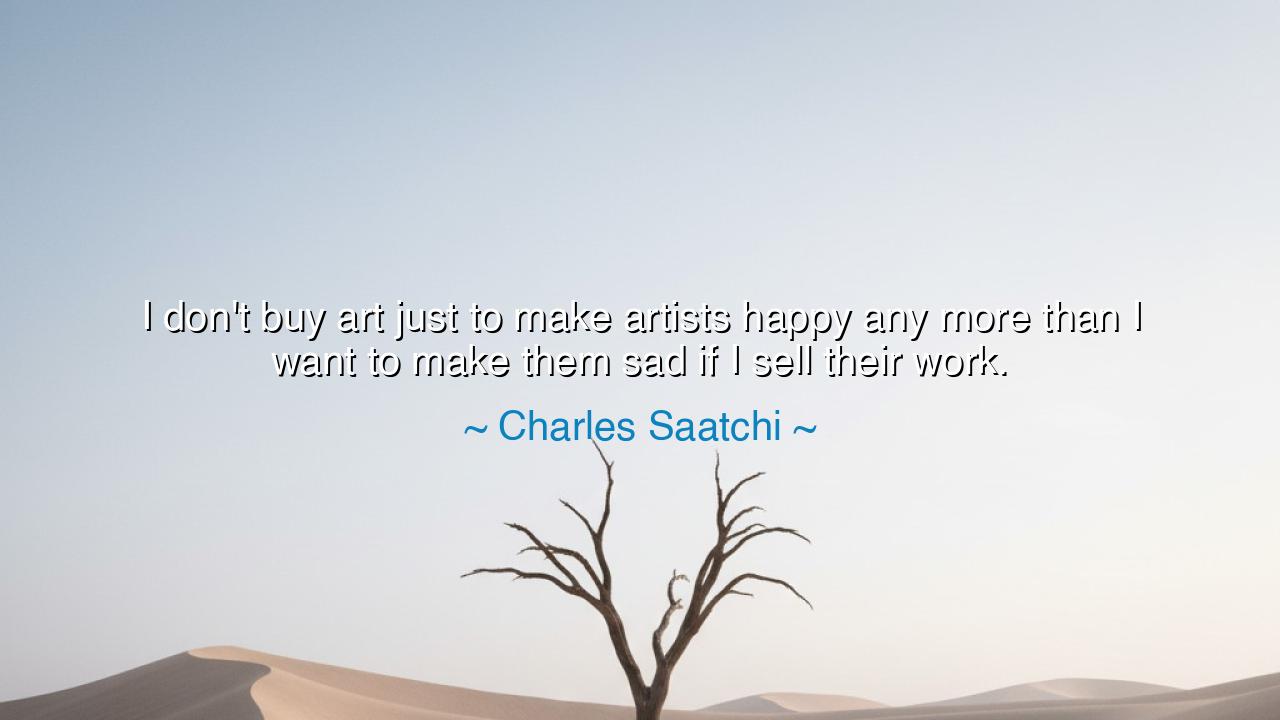
I don't buy art just to make artists happy any more than I want
I don't buy art just to make artists happy any more than I want to make them sad if I sell their work.






Charles Saatchi once declared with cool honesty and ancient wisdom: "I don't buy art just to make artists happy any more than I want to make them sad if I sell their work." Within these words lies a profound reflection on the nature of art, attachment, and truth. He speaks not only as a collector of paintings, but as a philosopher of desire—one who understands that art, once born, belongs not to emotion but to the world. Saatchi’s statement is a reminder that true appreciation is neither charity nor cruelty; it is reverence without illusion. The artist’s joy or sorrow cannot determine the destiny of the creation, for once the brush lifts, the work begins its own life, free from the hands that made it.
In the age of emperors and poets, such a thought would have been called detachment—the discipline of seeing beauty without possession. The ancients taught that the value of a thing does not lie in the joy it gives its maker, but in the truth it reveals to the beholder. When Saatchi says he does not buy art to make artists happy, he speaks to the danger of sentiment clouding judgment. For love without clarity becomes pity, and pity can blind the eyes that ought to see clearly. To love art is to honor its spirit, not to bind oneself to its creator’s feelings.
Consider the story of the great Chinese Emperor Huizong, himself a painter and a collector. He surrounded himself with artists, praising their work with golden words and gifts of jade. But in his indulgence, he forgot the discipline of discernment. When war came, his empire fell, and his vast galleries were looted. What he had gathered with affection, he lost through blindness. Saatchi, by contrast, speaks of a wisdom forged in fire—the understanding that emotion must not rule over art, for the collector’s duty is to preserve truth, not sentiment.
The artist’s pain at a sale or their joy at a purchase are but ripples upon the greater sea of creation. A painting, a sculpture, a poem—they are vessels of something immortal, yet their owners and makers are bound by time. Saatchi reminds us that to worship the feelings of the artist is to mistake the vessel for the wine. When he says he does not wish to make them sad if he sells their work, he acknowledges that detachment is not cruelty—it is balance. The true lover of art must stand between compassion and clarity, holding both without being enslaved by either.
In every realm of creation—be it art, love, or leadership—the same principle endures: one must act from truth, not from the fear of causing offense. The sculptor must strike the marble even if the blow seems harsh; the teacher must correct the student even if the lesson stings. So too must the collector sell a masterpiece if the time demands it, for the value of art lies not in sentiment, but in its dialogue with eternity. To cling too tightly to another’s feeling is to lose sight of the eternal thread that connects all creators, buyers, and beholders.
Let us not misunderstand: Saatchi does not speak as one without heart, but as one who has learned restraint through experience. His words are a shield against the confusion of compassion and responsibility. True respect for the artist lies not in indulging emotion but in honoring the integrity of the work. For what greater insult could there be than to treat art as pity? To buy out of mercy is to deny the artist the dignity of mastery. To sell out of necessity is not betrayal, but the continuation of art’s journey through time.
Thus, the lesson endures: detach without disdain, love without possession, act without apology. The wise learn to hold beauty with open hands. Whether one is an artist, collector, or mere admirer, the secret is the same—do not serve art as a slave, but walk beside it as a friend. When you create, do so with freedom; when you admire, do so with honesty; and when you must let go, release without guilt. For art, like life, must move from hand to hand, from heart to heart, carrying with it the pulse of all who dared to see it clearly.
So remember, O seekers of truth and beauty: the purpose of art is not to please, but to reveal. Do not chain it with sentiment, nor measure it by smiles or tears. Love deeply, but let go lightly—that is the wisdom of Saatchi’s words, and the eternal art of living itself.






AAdministratorAdministrator
Welcome, honored guests. Please leave a comment, we will respond soon